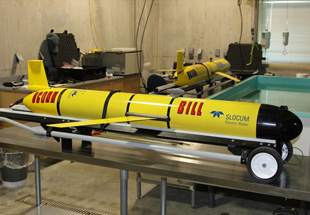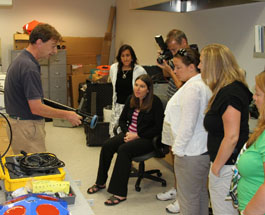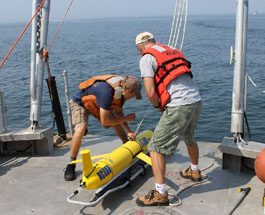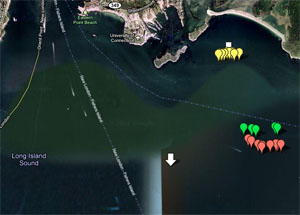The Ocean Technology – Gliders

UConn’s “Bill” and “Frank” underwater gliders being prepped in the Glider Laboratory |
Although the concept and design of autonomous ocean gliders is not new, dating back over two decades with the historical paper of Henry Stommel, the “Slocum Mission”, their application to ocean sampling has rapidly increased over the past few years. Gliders allow sampling of ocean data over longer space and time scales due to their low consumption of power. The efficiency of these vehicles is achieved by their ability to glide through the water in an undulating pattern that is established by fine-tuning the ballast, which causes the winged vehicle to fly downward through the water column, collecting data during this descent. An on-board computer program then instructs the vehicle to alter its buoyancy to float upwards through the water column until it returns to the surface. At the surface the vehicle uses satellite telemetry to transmit the data collected back to shore. This sampling scheme of yo-yoing through the water column is often conducted along a linear transect and/or an offshore/onshore sampling pattern.
The Teacher Technology Experience – "Glide with the Tide"

Educators receiving an overview of CTD and ADCP technologies in Dr. O’Donnell’s lab. |
Dr. Jim O’Donnell, a physical oceanographer at the University of Connecticut’s Department of Marine Sciences led the first COSEE-TEK Teacher Technology Experience (TTE) that focused on several technologies used to sample the dynamic physical oceanography of the near shore environment of Long Island Sound (LIS). The technologies used included a conductivity, temperature and depth (CTD) sampler, an acoustic doppler current profiler (ADCP) and an autonomous underwater glider to collect a range of data in Long Island Sound. This combination of technologies provided point (CTD), transect (glider) and time series (ADCP) data to assess the physical characteristics of coastal LIS.

Three formal educators and one informal educator received a one-day orientation on the physical oceanography of Long Island Sound and the technologies used to measure the daily, seasonal and annual dynamics of this coastal region. They then received lab-based training on the design and operation of the CTD, ADCP and gliders from Dr. O’Donnell and research technicians Kay Howard-Strobel and Dennis Arbige. The day ended with a tour of a wide range of ocean technologies used by scientists at UConn’s Department of Marine Sciences.
The next day of the professional development workshop included an on-water experience that included deploying the ADCP, launching the glider on three short transects and conducting several CTD casts from shallow to deeper water in the Sound. The teachers followed the glider from UConn’s Research Vessel Lowell Weicker and recorded the time and location each time it surfaced during its “yo-yo” transect that profiled the shallow water of the Sound. This data was later used to plot each of the three transects conducted.

ADCP, glider and CTD deployment locations in LIS. |
The third day of the workshop entailed reviewing and analyzing the CTD profiles, which included importing the raw data files into a spreadsheet and developing plots of the data. They also returned to recover the ADCP that had been deployed the day before which provided a 24 hour data set of the water current direction and speed. The teachers integrated the location information recorded the previous day into a geographical context using Google Earth that will be made available on the COSEE-TEK website.
The latter part of the third day entailed an opportunity for the researchers to receive professional development from the educators on the challenges to implementing broader impacts within both the formal and informal educational contexts. This peer-to-peer exchange included a discussion of the limitations imposed by the National Science Education Standards, Connecticut science education Frameworks and mandated testing.
The teachers and educator then spent the last day drafting ideas on how the data can be used in the development of lesson plans or public outreach tools for use in the classroom and educational centers. They also discussed and searched the web for other data sets collected by other oceanographic institutions that could be used as potential comparative or longitudinal data sets.
For More Information
Rudnick, D.L, Davis, R.E., Eriksen, C.C., Fratontoni, D. M., Perry, M.J. 2004. Underwater Gliders for Ocean Research. Marine Technology Society Journal pp: 48-59.
Wikipedia contributors. Underwater glider [Internet]. Wikipedia, The Free Encyclopedia; 2011 Apr 9 [Cited 2011 May 13]. Available from: http://en.wikipedia.org/wiki/Underwater_glider.
Underwater Glider Spray: Description [Internet]. Scripps Institution of Oceanography. Cited 2011 May 13. Available from: http://spray.ucsd.edu/pub/rel/info/spray_description.php#REF.
Monitoring Your Sound (MYSound) [Internet]. University of Connecticut: Department of Marine Sciences. Cited 2011 May 13. Available from: http://www.mysound.uconn.edu.











